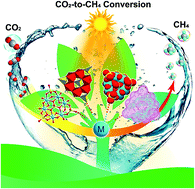当前位置:
X-MOL 学术
›
Chem. Sci.
›
论文详情
Our official English website, www.x-mol.net, welcomes your
feedback! (Note: you will need to create a separate account there.)
Hetero-metallic active sites coupled with strongly reductive polyoxometalate for selective photocatalytic CO2-to-CH4 conversion in water†
Chemical Science ( IF 7.6 ) Pub Date : 2018-10-02 00:00:00 , DOI: 10.1039/c8sc03471k Shuai-Lei Xie 1 , Jiang Liu 2 , Long-Zhang Dong 2 , Shun-Li Li 2 , Ya-Qian Lan 2 , Zhong-Min Su 1, 3
Chemical Science ( IF 7.6 ) Pub Date : 2018-10-02 00:00:00 , DOI: 10.1039/c8sc03471k Shuai-Lei Xie 1 , Jiang Liu 2 , Long-Zhang Dong 2 , Shun-Li Li 2 , Ya-Qian Lan 2 , Zhong-Min Su 1, 3
Affiliation

|
The photocatalytic reduction of CO2 to value-added methane (CH4) has been a promising strategy for sustainable energy development, but it is challenging to trigger this reaction because of its necessary eight-electron transfer process. In this work, an efficient photocatalytic CO2-to-CH4 reduction reaction was achieved for the first time in aqueous solution by using two crystalline heterogeneous catalysts, H{[Na2K4Mn4(PO4) (H2O)4]⊂{[Mo6O12(OH)3(HPO4)3(PO4)]4[Mn6(H2O)4]}·16H2O (NENU-605) and H{[Na6CoMn3(PO4)(H2O)4]⊂{[Mo6O12(OH)3(HPO4)3(PO4)]4[Co1.5Mn4.5]}·21H2O (NENU-606). Both compounds have similar host inorganic polyoxometalate (POM) structures constructed with strong reductive {P4Mo6V} units, homo/hetero transition metal ions (MnII/CoIIMnII) and alkali metal ions (K+ and/or Na+). It is noted that the {P4Mo6V} cluster including the six MoV atoms served as a multi-electron donor in the case of a photocatalytic reaction, while the transition metal ions functioned as catalytically active sites for adsorbing and activating CO2 molecules. Additionally, the presence of alkali metal ions was believed to assist in the capture of more CO2 for the photocatalytic reaction. The synergistic combination of the above-mentioned components in NENU-605 and NENU-606 effectively facilitates the accomplishment of the required eight-electron transfer process for CH4 evolution. Furthermore, NENU-606 containing hetero-metallic active sites finally exhibited higher CH4 generation selectivity (85.5%) than NENU-605 (76.6%).
中文翻译:

异金属活性位点与强还原性多金属氧酸盐结合用于选择性光催化水中 CO2 转化为 CH4†
CO 2光催化还原为增值甲烷(CH 4 )一直是可持续能源发展的一种有前途的策略,但由于其必要的八电子转移过程,触发该反应具有挑战性。 在这项工作中,通过使用两种结晶非均相催化剂H{[Na 2 K 4 Mn 4 (PO 4 ) (H 2 O)],首次在水溶液中实现了高效的光催化CO 2 -to-CH 4还原反应。 4 ]⊂{[Mo 6 O 12 (OH) 3 (HPO 4 ) 3 (PO 4 )] 4 [Mn 6 (H 2 O) 4 ]}·16H 2 O ( NENU-605 ) 和 H{[Na 6 CoMn 3 (PO 4 )(H 2 O) 4 ]⊂{[Mo 6 O 12 (OH) 3 (HPO 4 ) 3 (PO 4 )] 4 [Co 1.5 Mn 4.5 ]}·21H 2 O ( NENU-606 )。 两种化合物具有相似的主体无机多金属氧酸盐 (POM) 结构,由强还原性 {P 4 Mo 6 V } 单元、同/杂过渡金属离子 (Mn II /Co II Mn II ) 和碱金属离子 (K +和/或 Na) 构成+ )。值得注意的是,在光催化反应的情况下,包含六个Mo V原子的{P 4 Mo 6 V }簇充当多电子供体,而过渡金属离子充当吸附和活化CO 2的催化活性位点。分子。另外,碱金属离子的存在被认为有助于捕获更多的CO 2用于光催化反应。 NENU-605和NENU-606中上述组分的协同组合有效地促进了CH 4演化所需的八电子转移过程的完成。此外,含有异金属活性位点的NENU-606最终表现出比NENU-605 (76.6%)更高的CH 4生成选择性(85.5%)。
更新日期:2018-10-02
中文翻译:

异金属活性位点与强还原性多金属氧酸盐结合用于选择性光催化水中 CO2 转化为 CH4†
CO 2光催化还原为增值甲烷(CH 4 )一直是可持续能源发展的一种有前途的策略,但由于其必要的八电子转移过程,触发该反应具有挑战性。 在这项工作中,通过使用两种结晶非均相催化剂H{[Na 2 K 4 Mn 4 (PO 4 ) (H 2 O)],首次在水溶液中实现了高效的光催化CO 2 -to-CH 4还原反应。 4 ]⊂{[Mo 6 O 12 (OH) 3 (HPO 4 ) 3 (PO 4 )] 4 [Mn 6 (H 2 O) 4 ]}·16H 2 O ( NENU-605 ) 和 H{[Na 6 CoMn 3 (PO 4 )(H 2 O) 4 ]⊂{[Mo 6 O 12 (OH) 3 (HPO 4 ) 3 (PO 4 )] 4 [Co 1.5 Mn 4.5 ]}·21H 2 O ( NENU-606 )。 两种化合物具有相似的主体无机多金属氧酸盐 (POM) 结构,由强还原性 {P 4 Mo 6 V } 单元、同/杂过渡金属离子 (Mn II /Co II Mn II ) 和碱金属离子 (K +和/或 Na) 构成+ )。值得注意的是,在光催化反应的情况下,包含六个Mo V原子的{P 4 Mo 6 V }簇充当多电子供体,而过渡金属离子充当吸附和活化CO 2的催化活性位点。分子。另外,碱金属离子的存在被认为有助于捕获更多的CO 2用于光催化反应。 NENU-605和NENU-606中上述组分的协同组合有效地促进了CH 4演化所需的八电子转移过程的完成。此外,含有异金属活性位点的NENU-606最终表现出比NENU-605 (76.6%)更高的CH 4生成选择性(85.5%)。











































 京公网安备 11010802027423号
京公网安备 11010802027423号